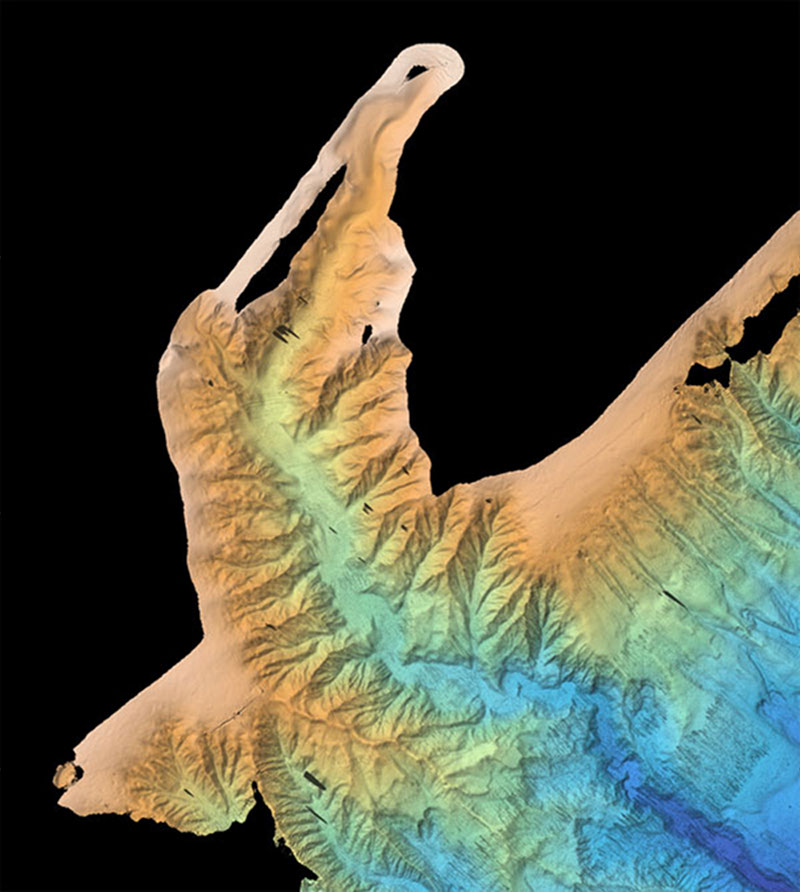
Steve Ross, Research Professor - University of North Carolina-Wilmington, Center for Marine Science
August 15 - October 1, 2012

The primary target areas for the Deepwater Mid-Atlantic Canyons Project are in and around the Norfolk, Washington, Accomac, and Baltimore canyons. This map shows places where deep-sea corals were previously identified (indicated by yellow and pink stars) as well as locations of previous submersible dives (green, blue, and red circles). Image courtesy of SW Ross, UNC-W. Download image (jpg, 120 KB).
The Mid-Atlantic Deepwater Canyons project is co-funded by the Bureau of Ocean Energy Management (BOEM) and NOAA’s Office of Ocean Exploration and Research and the U.S. Geological Survey (USGS). The project is managed by Continental Shelf Associates, and includes scientific partners from several academic institutions. The project will focus on the exploration and characterization of hard bottom communities (particularly deep-water corals), soft-bottom communities and shipwreck sites in canyons off Virginia and Maryland. Selected shipwreck sites will be studied to determine their historical significance and their function as artificial habitat for canyon fauna. The biology and ecology of these canyons is poorly described, and they harbor significant unexplored historical artifacts. Our study will provide valuable information to regulatory agencies on distribution of sensitive areas within the canyons, as well as contributing scientific information on these ecologically important ecosystems as well as consideration in advance of any potential future energy development.
The fieldwork for this project began in June 2011 when NOAA Ship Nancy Foster conducted multibeam sonar mapping of major canyons and shipwreck sites in the study region. This cruise resulted in nearly 1,400 sq. km of detailed seafloor maps, nine new shipwreck targets, 32 environmental profiles of the water column and a shipboard outreach effort to communicate our findings to the public. Our upcoming research cruise aboard the NOAA ship Nancy Foster this summer will focus on Baltimore and Norfolk Canyons, using the Kraken II Remotely Operated Vehicle (University of Connecticut) to conduct video and photo transects, collect samples of invertebrates and fishes for various biological studies, deploy instruments to collect long-term environmental data and survey several archaeological sites. We will have a strong education and public outreach component to the cruise which will enable the public to follow our progress as we explore these little known ecosystems.
By Greg Boland
The unique nature of the partnerships enables each agency and institution to bring its expertise and resources together to create a successful and effective team for both exploration and providing necessary applied science for the management of energy resources.
Read moreBy Sandra Brooke and Amanda W.J. Demopoulos
This project has a wide variety of scientific objectives that investigate biology and ecology of different types of seafloor communities, oceanography and archeological sites within and adjacent to deep-water canyons off Virginia and Maryland. The 2012 research cruise will be divided into three separate legs; the first two will explore natural ecosystems and habitats found within the canyons, and the third will examine historical shipwrecks and their biological communities.
Read moreBy Steve W. Ross and Sandra Brooke
Cutting deeply into the bottom and linking the shelf to the deep sea, canyons are conduits that funnel anthropogenic pollutants, organic carbon, and sediments from shallow to deeper waters. The most southerly of these canyons (just north of Cape Hatteras) occurs in an extremely dynamic and productive area known as “The Point”.
Read moreBy Sandra Brooke
Hard rocky habitats in areas of high current are often colonized by sessile benthic animals such as corals and sponges; this is true everywhere, from the shallow coastal areas to the deep sea.
Read moreBy Steve W. Ross
Information, particularly long-term monitoring data, on deep-sea habitats is limited. Detailed, longer-term data on physical variability are key to understanding unique slope habitats, such as deep-sea coral reefs and canyons, yet this information is largely lacking or is very general.
Read more